22 Aug 2014 | Egypt, Middle East and North Africa, News and features
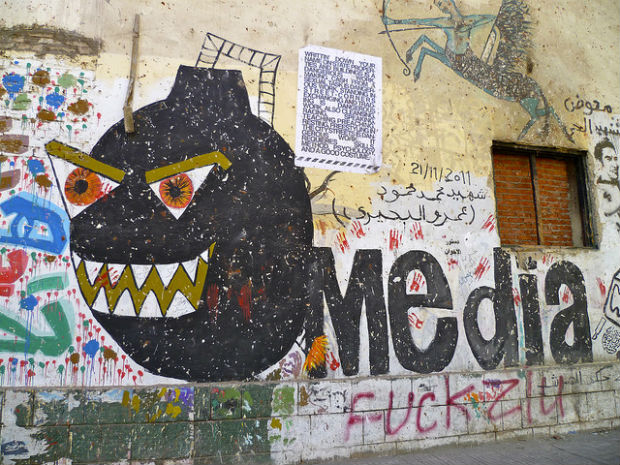
Street art from Mohamed Mahmoud Street, Cairo. (Photo: Melody Patry/Index on Censorship)
Before the January 2011 uprising, street art was little known in Egypt. Then came the revolution and with it, an outburst of creativity.
With the fall of the authoritarian regime of Hosni Mubarak, Egyptian artists who had routinely faced censorship restrictions under his autocratic rule, felt a strong urge to break out of the confines of their studios and reclaim public spaces. Young artists in particular, decided they needed bigger canvases for the grand ideas they wanted to convey through their paintings. To celebrate their newfound liberation, many of them took their art directly to the people and onto the streets, expressing their views and opinions on public walls and on the sides of buildings.
Bonded by their shared aspirations for a better Egypt, the young graffiti artists spent long hours working together, creating vivid group murals that told the stories of the revolution in which they had actively participated. The images they produced in the months following the 2011 uprising documented the dramatic changes that were unfolding in the country, the continued unrest ensuring a steady supply of material for them to work with. The artists also spread powerful messages of “equality” and “freedom” that helped shape public opinion, attitudes and values.
“Our murals added colour to the otherwise dull streets and boosted the morale of the people. But as graffiti artists and activists, we also played the role of the ‘alternative critical media,’ telling the untold stories and spreading messages that helped the public better understand what was really happening on the ground,” said graffiti artist Salma Sami, a graduate of fine arts who has also worked as a broadcaster.
An image of Pinnochio on TV, spray-painted on a wall on Mohamed Mahmoud Street, off Tahrir Square, shortly after the fall of Mubarak, was intended to poke fun at state media — for long, a propaganda tool of the ousted Mubarak regime. According to Sami, the mural also “serves as a warning to Egyptians not to believe everything the media tells them”.
Besides being a critical voice, raising awareness and informing the public of the events unfolding in the country, Cairo’s nascent street art movement also helped keep the spirit of the January 25 revolution alive.
“As a woman, I wasn’t accustomed to working in the street and was afraid at first especially after hearing stories of sexual assault incidents in the very neighbourhood where we worked. But once I started working, I felt safe. Working in a group helped us revive the spirit of the revolution, letting go of our fears and uniting behind a common goal,” Sami said.
The street artists successfully managed to break down social barriers of class, religion and gender. They created a close-knit community among themselves but were also accessible to the public.
“Crowds would often gather to watch as we worked and then, someone would volunteer to help. Soon, we would find others joining in. The fact that a lot of our work was painted with roller brushes made it easy for anyone to participate,” Sami told Index.
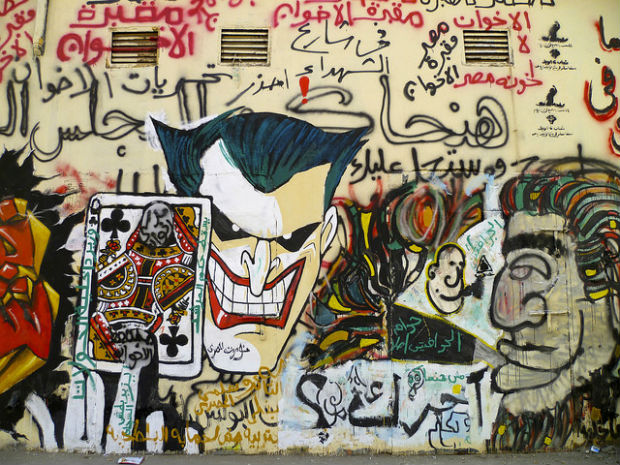
(Photo: Melody Patry/Index on Censorship)
Like Sami, Bahia Shehab — an art historian and graphic designer — was also very much a part of the street art movement that emerged and developed after the 2011 revolution. Her trademark “no” stencils, spray painted on the walls of Mohamed Mahmoud Street have helped draw public attention to social problems, exhorting Egyptians to take a stand against violence, oppression, and other forms of injustice.
Shehab joined the street art movement nine months after the revolution when she saw an image of a protester’s corpse dumped in a pile of rubbish in her Facebook newsfeed. The gruesome picture, which had gone viral on social media networks, so infuriated her that she rushed to Tahrir Square to express her rage. Her stencilled message “no to military rule” marked the beginning of her “thousand times no” campaign — a series of images decrying torture, sexual violence and other issues she felt strongly about.
Carrying on the idea from her 2010 book — a compilation of “one thousand no-s” in a multitude of Arabic calligraphy styles — she added a range of fiery messages denouncing rights abuses that were committed during the country’s transitional period. ”No to violence and thuggery”, “no to stripping girls” and “no to sectarian divisions” are just a few in her long list of stencilled images.
More than three years after the uprising that toppled autocrat Hosni Mubarak, Shehab says her “old” list is “still relevant” and her concerns “still valid”. She continues to consistently add more “no” messages, saying she is “deeply disappointed” with the turn of events in her country. Among the new additions is a stencil calling for an end to the brutal security crackdown on dissent.
A nationalist fervour sweeping the country has however made it dangerous for graffiti artists to express themselves freely. Those who dare criticise government policies are often accused of being “traitors” and “terrorists” by self-proclaimed “patriots”. Today, while many of the young street artists view former army chief and current president Abdel Fattah el-Sisi as merely the new face of the old military regime, few dare depict him in their artworks. Sisi came to power following the 2013 coup that overthrew Egypt’s first democratically elected president, the Muslim Brotherhood’s Mohamed Morsi. Several established street artists have chosen to remain anonymous, signing their artworks using nicknames for the sake of their security.
“Working in the street has always been dangerous,” noted Shehab, adding that “the only difference is that the danger now comes from violent ‘patriotic’ mobs supporting the military where before it was from the police.”
But mob violence is not the only danger threatening Egypt’s street art movement. A proposed draft law banning so-called “abusive graffiti art” — if passed — may likely restrict artistic expression and may spell the end of the graffiti tradition, even before it fully emerges. Under the draft law, violators could face a prison sentence of up to four years or a fine of up to 100,000 Egyptian pounds.
The recent alleged murder of one of Shehab’s comrades — 19 year-old graffiti artist and member of the April 6 youth movement Hisham Rizk — has compounded her fears, sending shivers down many spines in Egypt’s artistic circles. Rizk’s body was found in a Cairo morgue last month, a week after his family reported his “mysterious disappearance”. A forensic report concluded that the young artist had died of “asphyxiation by drowning in the Nile River”. Sceptical fellow artists however, believe Rizk’s critical views of the government expressed in his drawings and on Facebook may have instigated a confrontation with security officials that led to his death.
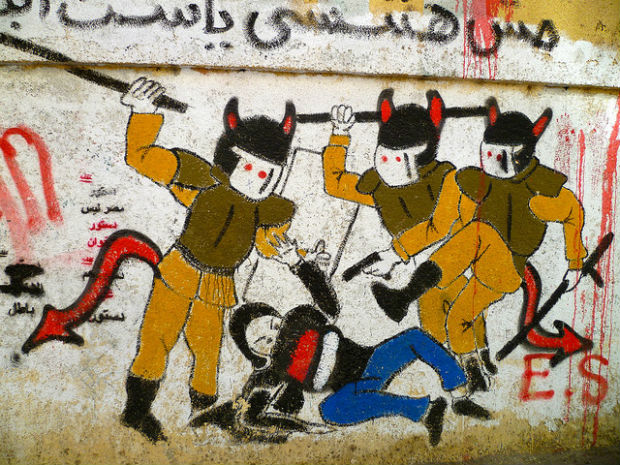
(Photo: Melody Patry/Index on Censorship)
“People don’t always agree with our views and different people interpret our artworks in different ways but at least our murals provide food for thought,” noted Sami who, in early 2012, designed a controversial mural depicting a skull with a military cap, holding a flower between clenched teeth. The image was a fitting portrayal of the brutal military regime that replaced Mubarak after the revolution. The 18-month rule of the Supreme Council of the Armed Forces (SCAF) was marred by political turmoil and violence including forced virginity tests performed by the military on female protesters
You can still see Sami’s mural on Mohamed Mahmoud Street, along with many others that are critical of both SCAF and the Muslim Brotherhood. The latter are depicted as sheep, while military men are portrayed as butchers in some of the murals. The colourful artworks are reminiscent of a happier time of free artistic expression and hope — a phase that, some of the artists fear, may well be over.
Yet, both Sami and Shehab remain defiant, saying that neither laws nor intimidation will deter them from the journey they have started. They draw similarities between their art and the 2011 revolution, saying both are constantly shifting and come in waves. Their murals in downtown Cairo have been whitewashed several times with other artists painting over them or adding new images as new events unfold, sparking new ideas. “Sometimes, residents in the area paint over the images if they oppose our views,” said Sami.
“I no longer mind when my work disappears. When that happens, I just tell myself it’s time to design a new stencil and I head straight back to Mohamed Mahmoud Street.”
The Index on Censorship interactive documentary Shout Art Loud explores how Egyptians use graffiti and other art forms to tackle the issue of sexual harassment and violence against women. Watch it here.
This article was posted on August 22, 2014 at indexoncensorship.org
18 Aug 2014 | News and features, Poland, Religion and Culture
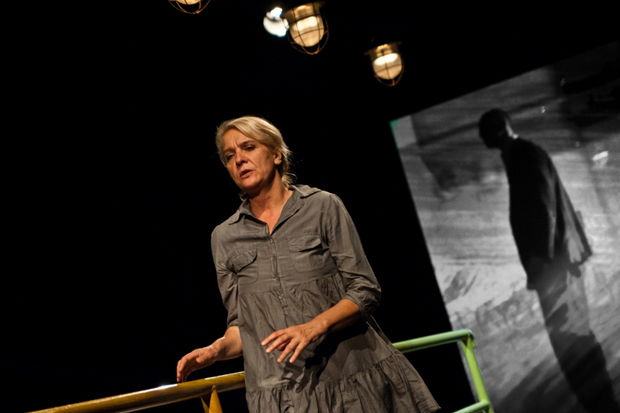
Ewa Wojciak has been working in the in theatre since the 1970s when she was a dissident artist under the communist regime. (Photo: Maciej Zakrzewski)
Ewa Wojciak, director of Poland’s Theatre of the Eighth Day, was fired by Poznan mayor Ryszard Grobelny on 28 July. His administration oversees culture and arts in the city, including Wojciak’s subversive and anti-establishment theatre group.
The official reason given was that she did not ask for permission to leave the city between 18 and 28 February, when she visited Yale and Princeton universities, performing her touring duties as director and actress with the theatre. However, these trips were not sponsored by the local government, so it is hard to see why she would need permission from authorities.
Wojciak’s career with the theatre began in 1970 when she was a dissident artist under the communist regime. After the end of communism, she turned the theatre into a welcoming space for refugees, minorities, anti-facists, feminists, lesbian, gay, bisexual, and transgender people and emerging theatre-makers. She has become a “new dissident”, confronting the realities of life after communism. During her tenure, the theatre, known for its artistic experimentation and politically subversive productions, has drawn the fire of Grobelny, known for his ultraconservative views.
The Theatre of the Eighth Day has played at the Edinburgh Festival, London’s LIFT, at the universities of Yale and Princeton, as well as innumerable major and small venues in Poland. The New York Times has written on their production under the heading “When Courageous Artists Ripped Holes in the Iron Curtain“.
During last month’s Index on Censorship debate with Timothy Garton Ash, Kate Maltby and David Edgar, about freedom 25 years after the fall of the Berlin Wall, I tried to emphasise how important such new dissidents are in Eastern Europe. Commenting on this debate, Index CEO Jodie Ginsberg reminded us how authorities are taking an increasingly hard line on civil society groups.
The Theatre of the Eighth Day, which helped build an alternative civil society under communism, continues its non-conformity — and faces threats from Poznan’s political establishment. Wojciak is being unfairly dismissed for defying the far right, clericalism, the “moral majority” and censorship.
Grobelny’s record as mayor of Poznan, a job he has held since 1998, leaves much to be desired in an open, democratic society. He has repeatedly stifled independent voices in the city, and Wojciak has been a long-standing adversary. In 2005, Grobelny banned the Equality March, a feminist-queer pride event. Wojciak and other members of the Theatre of the Eighth Day took part in this forbidden event, which was suppressed by the police — one of the actors was arrested. More recently, Grobelny also supported the Poznan ban of the play Golgota Picnic, on which Index has reported.
In 2013 Wojciak was reprimanded by the mayor for a comment on her Facebook wall immediately after the conclave of Pope Francis: “[T]hey’ve elected a prick who denounced left-wing priests under the military dictatorship in Argentina.” Her Facebook account was shut down and Wojciak — mistaken about the Pope’s involvement with the Argentinian junta — was vilified by Poland’s far right. Her Facebook account was later restored and the Poznan prosecutor declined to pursue the matter. At the time, intellectuals and artists defended her on grounds of free expression.
Adam Michnik, editor-in-chief of Poland’s leading broadsheet Gazeta Wyborcza and a legendary dissident, wrote that he supports Wojciak. Michnik is a member of the committee of the fiftieth anniversary of the Theatre of the Eighth Day. A petition protesting the dismissal of Wojciak has been issued by civic-educational initiative Otwarta Akademia (“Open Academy”), spearheaded by Piotr Piotrowski, an art historian and former director of Warsaw’s National Museum (who initiated the groundbreaking exhibition Ars Homo Erotica there), feminist Izabela Kowalczyk, artist Marek Wasilewski and ethicist Roman Kubicki, among others.
This petition has so far been signed by 317 people, including Irena Grudzinska-Gross of Princeton University and Alina Cala of the Jewish Historical Institute in Warsaw, who both write on anti-semitism in Poland; Elzbieta Matynia of the New School for Social Research and author of Performative Democracy; Jeffrey C. Goldfarb, author of The Persistence of Freedom: The Sociological Implications of Polish Student Theatre; and Pawel Leszkowicz of Poznan University, curator of Ars Homo Erotica.
The Theatre of the Eighth Day epitomises liberty: Wojciak and her company speak out against injustices and experiment aesthetically. It’s deplorable that they should be repressed by the authorities of their city.
If you would like to protest the dismissal of Ewa Wojciak, please email [email protected] with the subject “Ewa”.
This article was posted on August 18, 2014 at indexoncensorship.org
30 Jul 2014 | News and features, Poland, Religion and Culture
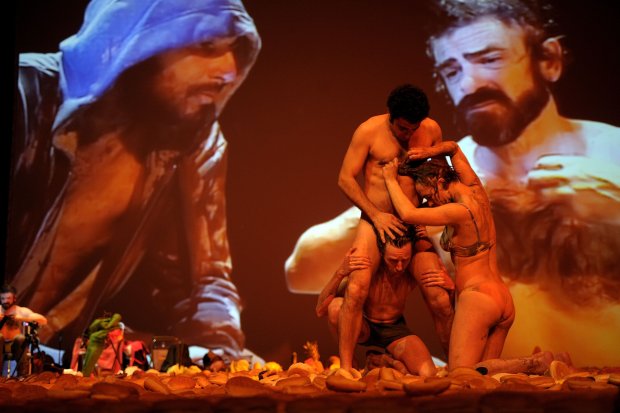
Golgota Picnic was pulled from a the Malta Festival in Poland after religious groups leveled threats.
The Polish theatre scene has been rocked by controversy since late June after the cancellation of Golgota Picnic, a show by the Argentinian theatre maker Rodrigo Garcìa that had previously aroused protest in France.
The play’s supposedly blasphemous content meant that Michał Merczyński, director of the Malta Festival, had pulled the headline show of his festival a week before its scheduled performance. The Malta Festival in Poznań is Poland’s answer to the Edinburgh Festival, and I was visiting with other directors from the Young Vic to learn more about Polish theatre culture. Our experience of the festival was derailed by claims and counter claims of blasphemy and censorship.
Merczyński’s decision to pull the show was based on information that a protest of 50,000 was planned and advice from the police that they could not guarantee the safety of the audience or the performers. The festival’s decision enraged large parts of secular Poland’s cultural elite, who feared that the police warning represented the state’s acquiescence to unofficial censorship by a group of interests centred upon the increasingly powerful Catholic church.
In reaction to the cancellation, there was a proliferation of protest screenings and staged readings of Golgota Picnic in theatres across Poland, some of which were variously picketed by a loose coalition of Catholics, neo-nazis and football hooligans. At the protest screening my group attended, at TR Warzsawa in Warsaw, these three groups all appeared to be embarrassed by each other. They prayed together and held placards warning that “Poland, motherland of Saint John-Paul II must not be a latrine for the trashes of the blasphemer, of the scoffers, of the traitors, of the barbarian and pseudo-artists”.
The Young Vic directors were jostled as we attempted to get in to the theatre and through the double cordon — first the protesters trying to stop us getting into the theatre, and then the police holding back the protesters. In the end we climbed over a low fence around a corner to get in and the police quickly bundled us into the building.
It’s important to say that this was much more exciting than it was scary. Here was evidence that theatre matters: people threatening hostility, if not quite violence, in response to an artwork. As far as I could make out from the DVD, Golgota Picnic (screened in Spanish with Polish subtitles) was a considered and beautiful meditation on the body and on Christ’s body in particular. Although it included a scene where a woman playing Jesus sculpted her gelled hair over another person’s genitalia, I’ve certainly seen more blasphemous plays. The crowd outside were fairly audible in their hymns and their chants, but — in the end, the protesters were defeated by the length of a piece of theatre. When we emerged two and a half hours later, they had given up and gone home.
The cancellation of Golgota Picnic left the Malta Festival deflated, but it felt as if these protests might be a powerful shot in the arm for Polish theatre culture in general. Several people we met were excited by the possibilities of the networks created and issues raised in the fight against religious censorship. Polish theatre provided a central political role in the end years of communism, and then lost its way only to be reinvented at the end of the nineties as a means to interrogate more universal themes in the formally explosive theatre of Gzegorz Jarzyna, Krzystof Warlikowski and Jan Klata, directors who still dominate the scene. It appears that Polish theatre is ripe for a new generation to redefine what theatre means.
As an outsider, this culture war looked complex and unhappy. Of course I was inside the theatre rather than on the street with a rosary, but it was clear that all the theatre people we met were well educated and well heeled. The Catholic protesters were not, and they felt like a demographic who had been left behind by the neo-liberalism that has replaced communism. It’s hardly surprising that these people are angry to see that “they are mocking us”, as one man complained to us on the steps of TR Warszawa.
It’s worrying to encounter theatre censorship in the EU, and artists should be free to present their work. At the same time, theatre institutions have a responsibility to ensure each piece of work finds its audience in the most productive way possible. With Golgota Picnic, the Malta Festival imported a show that had already caused protests elsewhere. Their marketing presented it as sexily controversial, and when this spectacularly backfired they cancelled the performance. Artists should shock and offend, but theatre makers and producers have to tread thoughtfully to ensure that the presentation of powerful work doesn’t play into the hands of those who would censor it.
Jeff James’s visit to Poland was supported by the Adam Mickiewicz Institute, the Young Vic and the Jerwood Charitable Foundation.
This article was posted on July 30, 2014 at indexoncensorship.org





